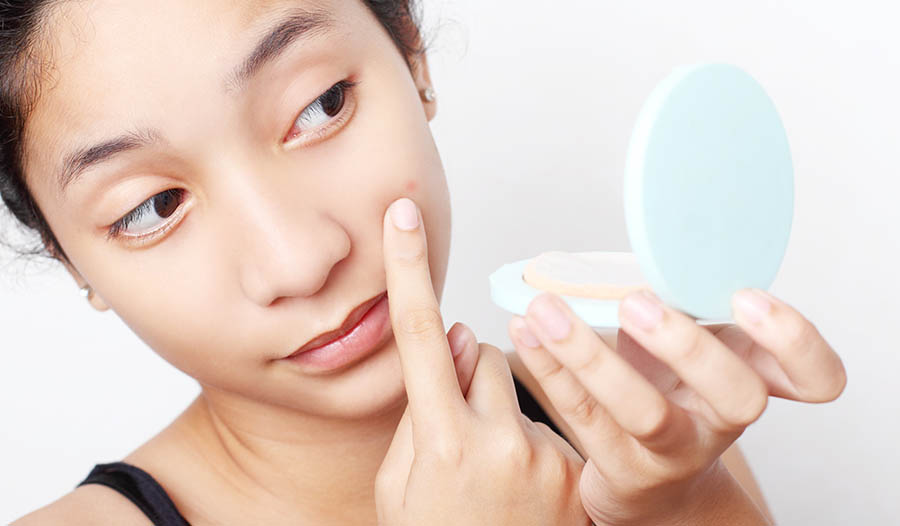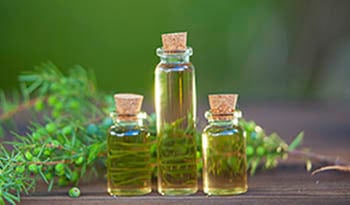5 Essential Nutrients for Healthy Teenage Skin: Tips for Clear and Radiant Complexion
DISCLAIMER:This blog does not intend to provide diagnosis...
- In this article:
- The Importance of the Right Types of Fat
- 5 Dietary Supplements to Support Skin Health
- 1. Zinc Skin Benefits
- 2. Chromium Skin Benefits
- 3. Vitamin B6 Skin Benefits
- 4. Selenium and Vitamin E Skin Benefits
- 5. Probiotic Skin Benefits
- Topical Tea Tree Oil for Acne
- DIY Tea Tree Solution for Acne
- Takeaway

Originally Posted April 2017 / Updated July 2023
Nutrition isn't a priority for most teens, even though the onslaught of hormones and stress of a growing body make good nutrition a must for various reasons.
Take acne, for instance. While theories about direct dietary influences on acne are controversial, there's no denying that proper nutrition can support healthy skin. In addition to a generally healthful diet, there are a few specific dietary recommendations for the teenager with acne:
- Eliminate or limit all refined or concentrated simple sugars.
- Eliminate or limit the intake of fried foods.
- Reduce the intake of saturated fats from animal products (meat and dairy).
- Eliminate or limit the intake of milk and dairy.
Of course, asking a teen to make these changes is often tricky. Seeing the full benefits will take some time, so trying a three-month commitment is a good trial.
The Importance of the Right Types of Fat
Eating suitable types of fats is essential to good health and healthy, radiant skin.
In addition to avoiding fried foods and too much dietary fat from animal sources, it is crucial to incorporate monounsaturated fats, essential fatty acids, and long-chain omega-3 fatty acids into the teenager's diet.
The best sources of monounsaturated fats are olive oil, avocados, and most nuts and seeds. The best sources of omega-6 and omega-3 essential fatty acids are flaxseed oil, chia seeds, pumpkin seeds, and walnuts.
It is also important to increase the consumption of the longer chain omega-3s EPA and DHA by including frequent fish consumption or using fish oil or algal-based supplements to provide EPA and DHA.
Fish oil supplements have significantly benefitted many skin disorders, including acne. An analysis of 38 human clinical studies concluded, "This review yielded many well-studied benefits of omega-3 fatty acid uses in dermatology."
Positive results have been shown in people dealing with common skin issues such as acne, eczema, and psoriasis. The daily dosage recommendation for high-quality fish oil or algae-based EPA+DHA supplement is 800 to 1,000 mg of EPA+DHA as that level ensures adequate intake.
5 Dietary Supplements to Support Skin Health
There are also other nutrients beyond essential fatty acids and EPA+DHA supplements that can help. Taking a quality multivitamin/multimineral formula could provide a strong foundation. But a few nutrients may need to be taken separately for maximum benefit.
1. Zinc Skin Benefits
Zinc is critical to normal skin function and the proper utilization of testosterone. Acne is associated with a localized increased activity of testosterone and other sex hormones within the skin, leading to increased sebum production and acne lesions. One of the reasons acne often occurs during puberty is the increase.
Interestingly, zinc levels are lowest in adolescent males than in any other age group. Human clinical studies that have utilized bioavailable forms of zinc in subjects with acne have showed impressive effects.
Results were similar to those seen with oral antibiotic treatment. A recent systematic review of all existing evidence from human clinical studies of zinc supplementation in acne concluded, "Zinc is effective for the treatment of acne, particularly at decreasing the number of inflammatory papules when used as monotherapy or as an adjunctive treatment."
Although some people show immediate improvement, most subjects in clinical trials who responded to zinc supplementation required about 12 weeks before seeing results. So, it will take some time before seeing the results. The typical dosage used in these studies was 30–45 mg daily. Zinc bound to picolinate, citrate, acetate, or monomethionine is recommended for better absorption, which means better results.
Zinc supplementation has shown to be helpful in other skin disorders, including rosacea, seborrheic dermatitis, and psoriasis.
2. Chromium Skin Benefits
Acne is linked to poor insulin sensitivity in the skin. Measuring glucose (blood sugar) levels in skin biopsies from acne sufferers showed impaired glucose utilization leading some researchers to refer to acne as "skin diabetes."
Fortunately, chromium supplementation has been shown to improve glucose tolerance and enhance the sensitivity of the skin cells to insulin. And this can lead to rapid improvements in patients with acne. Take 200–400 mcg daily. High chromium yeast or chromium bound to picolinate is recommended for better absorption.
3. Vitamin B6 Skin Benefits
Vitamin B6 is required to break down hormones in the liver. In teenagers, low levels of vitamin B6 can contribute to acne, mood swings, and sugar cravings. Vitamin B6 has been used successfully to treat acne flare-ups during the premenstrual period. Typical dosages are 25–100 mg daily.
4. Selenium and Vitamin E Skin Benefits
Selenium and Vitamin E play a role in glutathione peroxidase function, an enzyme that helps prevent acne inflammation. Typically, acne patients have decreased glutathione peroxidase levels, an important antioxidant enzyme in the skin.
Studies indicate that vitamin E and selenium supplementation increases glutathione peroxidase levels and significantly improves acne. Typical dosages are 100–200 IU for vitamin E and 100–400 mcg for selenium.
5. Probiotic Skin Benefits
The role of the gut microbiome, along with probiotic supplementation, has a long history of clinical evidence in improving acne and skin health. Though there have not been any trials of probiotic supplementation in teenagers with acne, several studies in adults have shown considerable benefit.
For example, in a double-blind, controlled trial of 20 adults with acne found a 32% reduction in acne in the group getting the probiotic (Lactobacillus rhamnosus) compared with placebo. Again, the results took about 12 weeks of supplementation.
Topical Tea Tree Oil for Acne
Tea tree oil possesses compounds that exert antimicrobial actions, including the bacteria that is linked to acne, Propionibacterium acnes.11 In one study in subjects with acne, a 5% tea tree oil solution used as a facial wash was shown to demonstrate similar beneficial effects to a 5% benzoyl peroxide solution, but the tea tree oil was much better tolerated.
There are many over-the-counter face washes available that contain tea tree oil.
DIY Tea Tree Solution for Acne
Here is a DIY tea tree oil cream as a nighttime treatment or use applied to blemishes as a spot treatment.
Ingredients:
- 10 drops of tea tree essential oil
- 2 Tbs. pure aloe vera gel
- 1/2 tsp. unrefined coconut oil
Instructions
- Mix the tea tree oil and aloe vera gel together.
- When thoroughly mixed, add the coconut oil
- Once blended, store in a small container with a lid.
Apply the cream before bed and rinse with warm water in the morning or use as a spot treatment on small blemishes.
Takeaway
While healthy, good-looking skin is only one of many reasons why a good diet and dietary supplements are crucial during the teenage years, it's also the benefit that appeals most to teens—especially those suffering from acne. I recommend parents use this information and encourage their kids to eat right and take appropriate supplements.
References:
- Baldwin H, Tan J. Effects of Diet on Acne and Its Response to Treatment. Am J Clin Dermatol. 2021 Jan;22(1):55-65.
- Guertler A, Neu K, Fiedler T, et al. Clinical effects of omega-3 fatty acids on acne vulgaris. J Dtsch Dermatol Ges. 2022 Jul;20(7):1023-1027.
- Thomsen BJ, Chow EY, Sapijaszko MJ. The Potential Uses of Omega-3 Fatty Acids in Dermatology: A Review. J Cutan Med Surg. 2020 Sep/Oct;24(5):481-494.
- Yee BE, Richards P, Sui JY, Marsch AF. Serum zinc levels and efficacy of zinc treatment in acne vulgaris: A systematic review and meta-analysis. Dermatol Ther. 2020 Nov;33(6):e14252.
- Zou P, Du Y, Yang C, Cao Y. Trace element zinc and skin disorders. Front Med (Lausanne). 2023 Jan 17;9:1093868.
- Sadowska-Przytocka A, Gruszczyńska M, Ostałowska A, Antosik P, Czarnecka-Operacz M, Adamski Z, Łącka K. Insulin resistance in the course of acne - literature review. Postepy Dermatol Alergol. 2022 Apr;39(2):231-238.
- McCarthy M. High chromium yeast for acne? Med Hypoth 1984; 14: 307–310.
- Snider B, Dieteman D. Pyridoxine therapy for premenstrual acne flare. Arch Dermatol 1974; 110: 130–131.
- Michaelsson G, Edqvist L. Erythrocyte glutathione peroxidase activity in acne vulgaris and the effect of selenium and vitamin E treatment. Acta Derm Venerol (StockH) 1984; 64: 9–14
- Siddiqui R, Makhlouf Z, Khan NA. The increasing importance of the gut microbiome in acne vulgaris. Folia Microbiol (Praha). 2022 Dec;67(6):825-835.
- Carson CF, Riley TV. The antimicrobial activity of tea tree oil. Med J Australia 1994; 160: 236
- Bassett IB, Pannowitz DL, Barnetson RSC. A comparative study of tea-tree oil versus benzoyl peroxide in the treatment of acne. Med J Australia 1990; 153: 455–458

 By Dr. Michael Murray, N.D.
By Dr. Michael Murray, N.D. 


